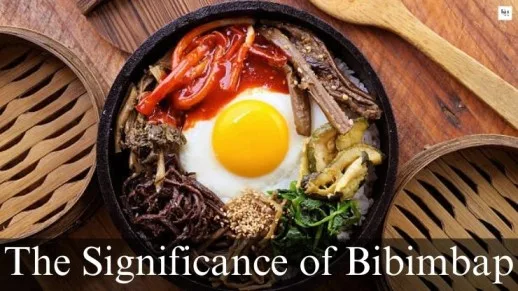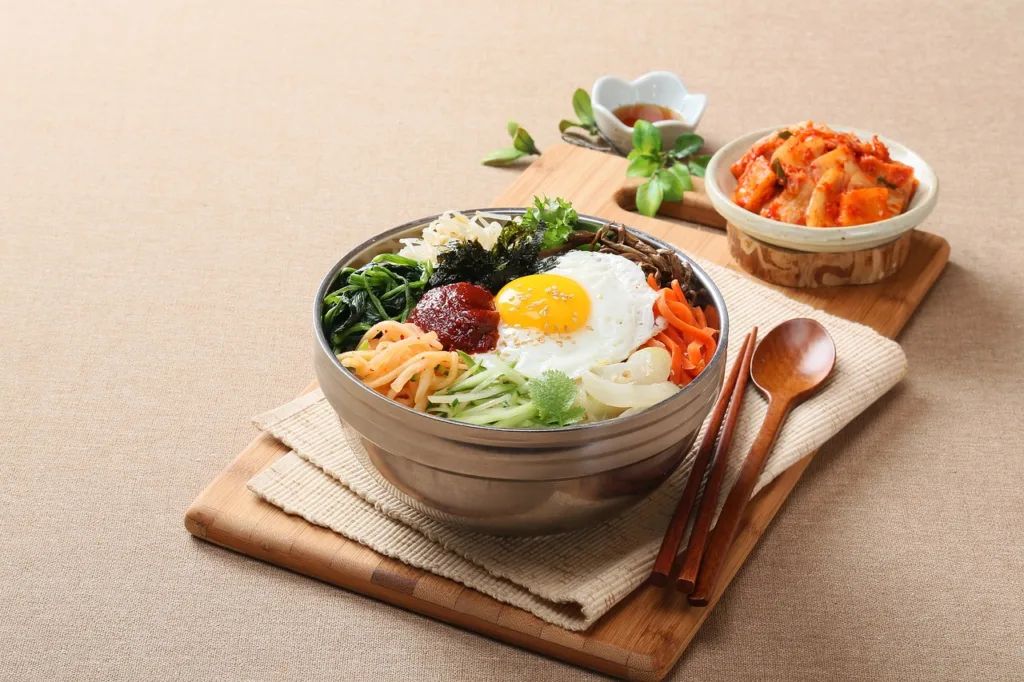
Bibimbap: Know The Recipe & Back Story | Korean Diet Recipe
Bibimbap, a popular Korean dish, is a colorful and tasty mix of vegetables, rice, and protein, topped with a spicy sauce. Not only is it delicious, but it is also incredibly nutritious, providing a balanced mix of macronutrients and micronutrients.
This dish has been enjoyed in Korea for centuries and has now become a favorite around the world.
Also read: Top 5 Places To Visit In South Korea | A Tourist Guide
Let me tell you the story of Bibimbap, a delicious Korean dish that has captivated the taste buds of millions around the world.

Legend has it that Bibimbap has been around since the late 16th century when King Jung Jong of the Joseon Dynasty served a dish that resembled what we now know as Bibimbap. However, it wasn’t until the early 20th century that Bibimbap became popular among the general population.
Bibimbap literally means “mixed rice,” and that’s exactly what it is. It consists of a bowl of steaming hot rice topped with various vegetables, meat, and a fried egg, all mixed together with a spicy chili paste called gochujang.
Also read: Know The Favorite Food Of BTS Members
The vegetables used in Bibimbap vary depending on the season and the region of Korea where it is made. Some of the most common vegetables used are carrots, spinach, bean sprouts, mushrooms, and zucchini. The meat used is typically beef or pork, although chicken or tofu can also be used as a vegetarian option.
Bibimbap is not just a delicious dish; it also has a deeper cultural significance. In Korean culture, it is customary to mix everything together before eating, symbolizing the importance of unity and harmony in society.
It is also a symbol of balance and nutrition, as the different colors and flavors of the ingredients represent the five elements of traditional Korean medicine: wood, fire, earth, metal, and water.
Today, Bibimbap is enjoyed not only in Korea but all around the world, thanks to its unique blend of flavors and textures. It has become a staple dish in Korean cuisine and is often served as a healthy and filling meal option.
In conclusion, the story of Bibimbap is one of tradition, balance, and unity. It represents the rich cultural heritage of Korea and has become a beloved dish around the world, a testament to its delicious and nutritious qualities.
Let’s take a closer look at the ingredients in bibimbap and the nutritional benefits it provides:
The ingredients in bibimbap are a combination of rice, vegetables, protein, and a spicy sauce. Here is a breakdown of the ingredients:
- 2 cups cooked rice
- 1/2 cup carrots, julienned
- 1/2 cup spinach, blanched
- 1/2 cup bean sprouts, blanched
- 1/2 cup zucchini, julienned
- 1/2 cup shiitake mushrooms, sliced
- 1/2 cup ground beef or tofu
- 1 tablespoon vegetable oil
- 1 clove garlic, minced
- 2 tablespoons gochujang (Korean chili paste)
- 1 tablespoon sesame oil
- 1 tablespoon soy sauce
- 1 tablespoon sugar
- 1 tablespoon sesame seeds
- 1 egg, fried or poached
Instructions:
- In a large pan, heat the vegetable oil over medium-high heat. Add the garlic and ground beef or tofu and cook until browned.
- Add the carrots, zucchini, and shiitake mushrooms to the pan and stir-fry until tender. Season with soy sauce and sugar.
- In a small bowl, mix together the gochujang, sesame oil, and a splash of water to make a sauce.
- To assemble the bibimbap, start with a layer of rice in a bowl. Arrange the cooked vegetables and ground beef or tofu on top. Add the egg on one side of the bowl.
- Drizzle the gochujang sauce over the top of the bibimbap and sprinkle with sesame seeds.
- Serve immediately and mix all the ingredients together before eating.
Nutritional Value:
One serving of bibimbap (including the ingredients listed above) provides approximately:
- Calories: 570
- Protein: 25g
- Fat: 20g
- Carbohydrates: 74g
- Fiber: 7g
- Sodium: 800mg
Significance:
Bibimbap is a healthy and balanced meal that provides a good source of protein, complex carbohydrates, fiber, and essential vitamins and minerals. The variety of vegetables used in this dish provides an excellent source of vitamins A and C, potassium, and iron. Gochujang, a key ingredient in the bibimbap sauce, is a fermented food containing probiotics that are beneficial for gut health.
The dish is also low in saturated fat and high in fiber, making it an excellent option for those looking to maintain a healthy weight and reduce the risk of heart disease.”
In conclusion, Bibimbap is not only a delicious and flavorful dish but also a nutritious and balanced meal that can provide a variety of health benefits. With its mix of vegetables, rice, and protein, bibimbap can satisfy your cravings while giving your body the nutrients it needs to function optimally.
So, if you’re looking for a healthy and easy-to-make dish that can spice up your meals, give bibimbap a try! You can easily customize this dish to your liking by adding your favorite vegetables and protein sources, making it a versatile option for any meal of the day.
Have you tried bibimbap before? Let us know in the comments below! And don’t forget to share this recipe with your friends and family who might be interested in exploring new cuisines and trying new flavors.




